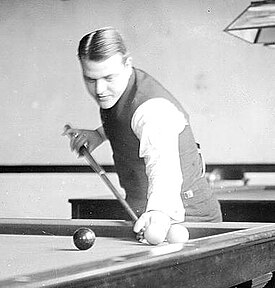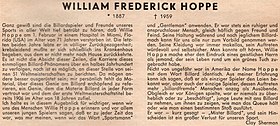Willie Hoppe
| William Frederick Hoppe | |
|---|---|
| Hoppe (approx. 1910-1915) | |
| Personal details | |
| birthday | October 11, 1887 |
| place of birth | Cornwall-on-Hudson, USA |
| date of death | February 1, 1959 |
| Place of death | Miami, Florida |
| nationality |
|
| Nickname (s) | Willie, The King |
| Active time | 1906-1952 |
| Achievements Unless otherwise stated, the information relates to the “three cushion” discipline. |
|
| Best GD: 1.333 | |
| (1950 - then world record) | |
| Maximum series (HS): 25 | |
| (1928) | |
| World Championships: | |
| 51 × | |
William Frederick Hoppe , better known as Willie Hoppe (born October 11, 1887 in Cornwall-on-Hudson , New York , USA , † February 1, 1959 in Miami , Florida ), was a multiple American pile-up world champion of German descent.
biography
childhood
Hoppe's father, a hotel owner, had set up a pool table in the adjoining barber shop as a diversion while his customers were waiting. At the age of five, Willie could barely look over the pool gang, he started playing. It quickly got better and became the attraction of the store. His sporting career began at the age of eight. It was worth half a dollar to one of the customers to show him and his two year older brother Frank, who was also a good player, demonstrations of their billiards skills. The father, burdened with mortgage debt, got an idea. He de-registered the children from school and the family roamed from town to town to show off the “child prodigies”. During the games he made bets with the spectators, after the game his mother collected the winnings. As they got better and better, they ventured to New York, to Maurice Daly's pool parlor. A contemporary reporter wrote of the children:
“The boys climb like monkeys from one edge of the billiards to the other because they cannot reach the center of the table. They sit on the boards and show the most intricate combinations while the audience stands there with their mouths open! "
Career
At that time there were three players who dominated the billiards scene, Jacob Schaefer senior (also a German-born American, was later his teacher, whom he could not defeat until his death in 1910), George Slosson and the Frenchman Maurice Vignaux . Their titles earned them an annual income of between US $ 10,000 (2019: approx. 313,546 US- $) and 25,000 US- $ (2019: approx. 783,865 US $). The world championship title could, as was common at the time, be won either through an advertised tournament or through a challenge. Willie's father telegraphed to Vignaux in Paris to challenge him, but initially received no answer. The "lion", as Vignaux was also called because of his head of hair, refused to compete against a child until he was 18 years old. The French dictated the conditions for this:

- The match must be played in Paris.
- All proceeds belong to the winner.
- The game is for 1,000 UD- $ (2019: approx. 29,269 US- $)
On January 15, 1906, this challenge match took place and Hoppe won 500: 323 with a world record average of 20.83, his first world title in Cadre 45/1 against Vignaux. The New York Times, which otherwise left little space for sports news, dedicated an 82-line report to the match. Shortly afterwards he set a new record in Cadre 45/2 with 622 points, the record was not broken until 1926. In 1914 there was a game between him and the Englishman Melbourne Inman , actually a player in English Billiards , which he lost 304: 602, although Hoppe was considered a favorite. His success lasted until 1924, then he lost the title, but was able to win it again in 1927. The time of the cadre in professional billiards was coming to an end and Hoppe switched to three cushion. In an exhibition match against the art pusher Charles C. Peterson in 1918, he put on his personal best high series (HS) of 25. There was a special encounter in 1925 in a game against three- cushion champion Robert Cannefax . Cannefax, who preferred faster cloths, asked the lead Hoppe to play at another table. Hoppe refused with the words: "The cloth is okay." Then Cannefax pulled out a pocket knife and cut the cloth in the middle. Hoppe was then awarded the game, and Cannefax was banned for a year. He never took part in a tournament again and died in 1928 of meningitis . In 1936, at the age of 48, he managed to get hold of the three-band crown. In a challenge game against Welker Chocran , Hoppe won 360: 246 in 340 shots. In 1940, 1941, 1942, 1947, 1949, 1950 and 1952 he was also victorious. At the 1940 World Cup in Chicago he was unbeaten in twenty games. During his defense of the three- cushion world championship title in Chicago in 1941, he had to withdraw from the competition and be admitted to the hospital - his flu had developed into pneumonia . When he was fighting for his life in St. Luke's Hospital, the world championship began with the best 17 players in the world without him, he should have been 18th. As a gesture to the ailing champion, the players agreed that they didn't want to give up any of his games. The tournament went on like this for a fortnight. On the fifteenth day, Hoppe, pale and shaky, complied with his commitment that a tournament would not be a tournament without him. He won his first game, albeit visibly weakened and barely able to hold the cue. After the game, he went to his hotel to rest when he was supposed to play his second game, which he then won. He won the third, fourth, and so on, until eventually winning all thirteen missed games in a row, including against Otto Reiselt, John Fitzpatrick, and Joe Chamaco. He then lost to Welker Cochran from San Francisco , won again three games in a row, until he finally faced title attacker Jacob Schaefer junior in the final , whom he could also beat. With this 16: 1 record - 17 games in 18 days - instead of 32 planned match days, he was able to successfully defend his world championship title.
In 1951 he set his personal record at a US championship with 1.331. At the age of 64, Hoppe played his last tournament in 1952 in San Francisco. He then promoted the game through game demonstrations. Hoppe was the only billiards player ever allowed to hold an exhibition match in the White House , and played before President William Taft in 1911 .
Between 1906 and 1952 Willie Hoppe won 51 world championships and wrote two books on billiards during that time.
death
Hoppe died of gastric bleeding in the presence of his brother Albert on February 1, 1959 at 4:40 p.m. in St. Francis Hospital in Miami. He had been hospitalized for cancer since September 1958.
Honors
In 1966, Hoppe was posthumously inducted into the Hall of Fame of the Billiard Congress of America . It ranks # 1 on the Billiards Digest 50 Greatest Players of the Century .
World title
- Professional World Champion in Cadre 45/1: 1906, 1908–1911 and 1914–1927
- Professional World Champion in Cadre 45/2: 1908, 1910–1920, 1923, 1924 and 1927
- Professional World Champion in three cushion: 1936, 1940–1943 and 1947–1952
Works
- Thomas Emmett Crozier (Ed.): Thirty Years of Billards . Putnam, New York 1925; Reprint: Dover Publications, New York 1975, ISBN 0-486-23126-7
- Billiards As It Should Be Played. 1941; Reprint: Contemporary Books, Incorporated, Chicago 1991, ISBN 0-8092-8837-0
Web links
- The Willie Hoppe Story Video (8:57 min, b / w) on YouTube.com.
Individual evidence
- ^ A b Billiards King Willie Hoppe died at 71 notice of death in the Lodi Nesw Sentinel dated February 2, 1959. Retrieved June 21, 2012.
- ↑ Legendary Players. Accessed May 24, 2014.
- ^ A b Willie Hoppe biography ( en ) Billiards Forum.info. Archived from the original on June 21, 2012. Retrieved June 21, 2012.
- ↑ a b c d Hoppe, Cue Great, Dies in The Milwaukee Sentinel, February 2, 1959. Retrieved June 21, 2012.
- ↑ a b c d e f g h Heinrich Weingartner : Willie Hoppe . The wounderchild. Ed .: billard Heinrich Weingartner . No. 12 . Self-published, 1988, ZDB -ID 1087098-2 , p. 21 (The article is taken from the following sources: "Thirty Years of Billiards", Willie Hoppe, 1925; "Billiards as it should be played", Willie Hoppe, 1941; "Esquire" Carl B. Wall, 1951).
- ↑ Chelsey Parrott-Sheffer, Thinley Kalsang Bhutia: Willie Hoppe. American Billiards Player. Encyclopedia Britannica, October 7, 2019, accessed June 21, 2012 .
- ^ Hoppe defeated at English Billards . In: New York Times . New York (English, nytimes.com [PDF; accessed April 4, 2012]).
- ^ Ailing Hoppe left hospital bed to beat the World's Best Cuemen in The Milwaukee Journal on February 4, 1959. Retrieved June 21, 2012.
- ^ Billiards Digest 50 Greatest Players of the Century . Retrieved July 15, 2012.
| personal data | |
|---|---|
| SURNAME | Hoppe, Willie |
| ALTERNATIVE NAMES | Hoppe, William Frederick (real name); The King (nickname) |
| BRIEF DESCRIPTION | American billiards player and 51-time world champion |
| DATE OF BIRTH | October 11, 1887 |
| PLACE OF BIRTH | Cornwall-on-Hudson , New York |
| DATE OF DEATH | February 1, 1959 |
| Place of death | Miami , Florida |


